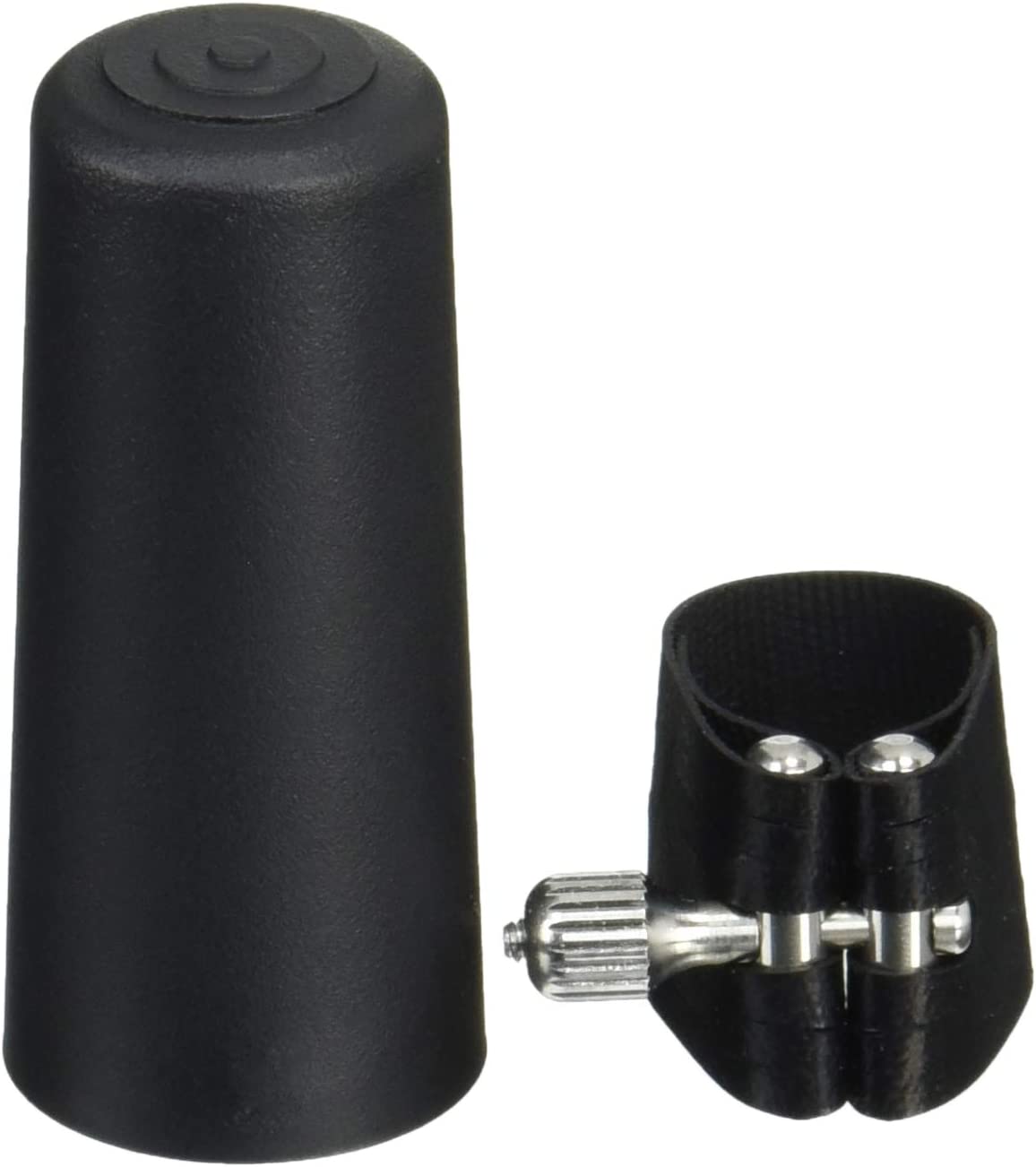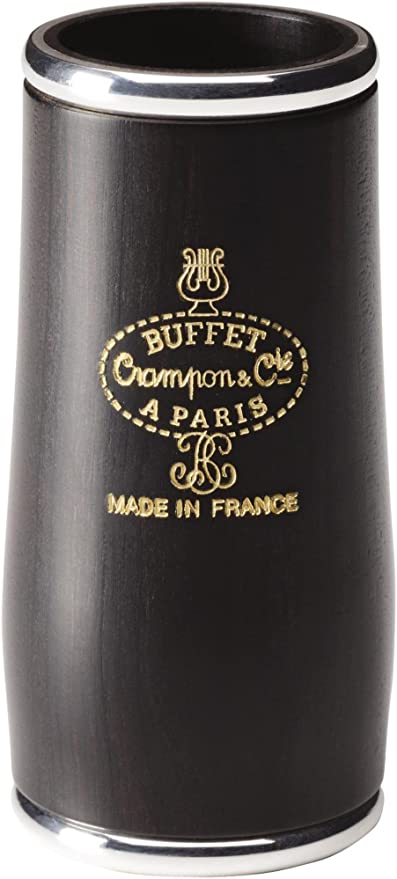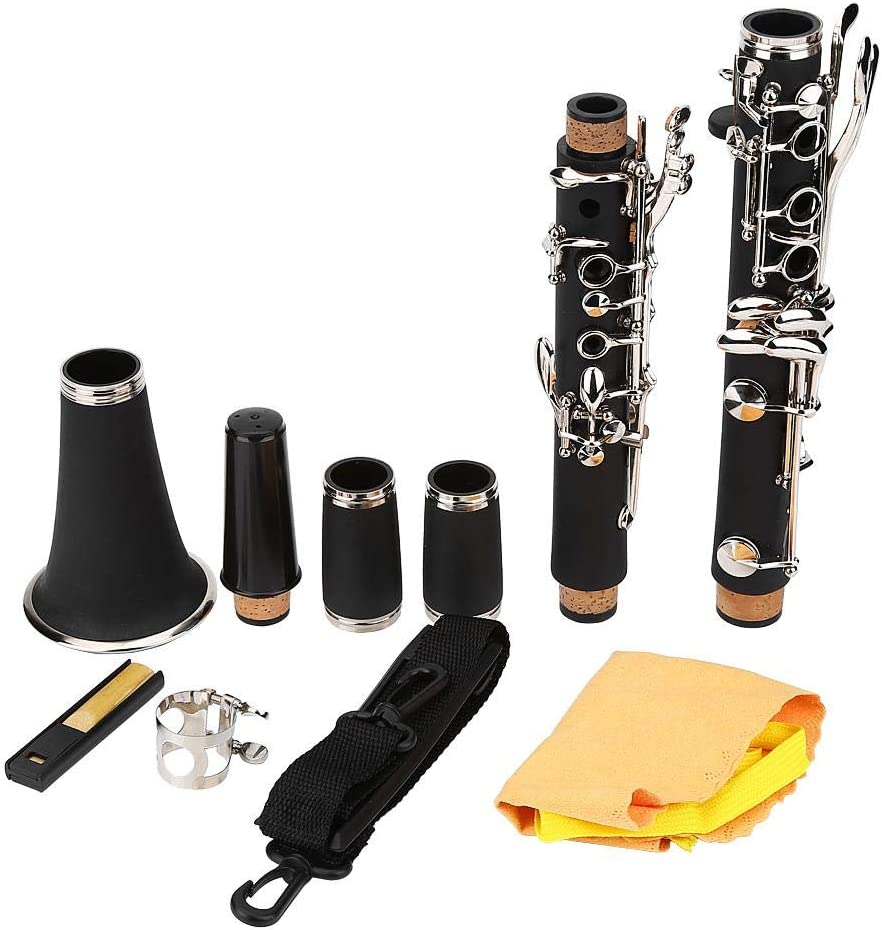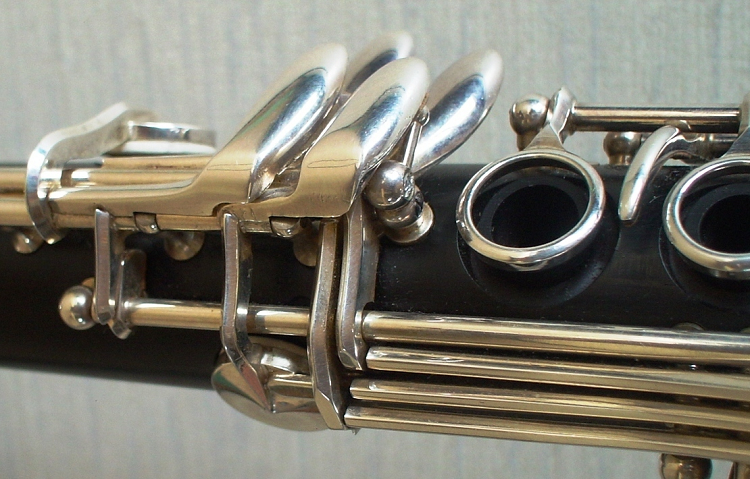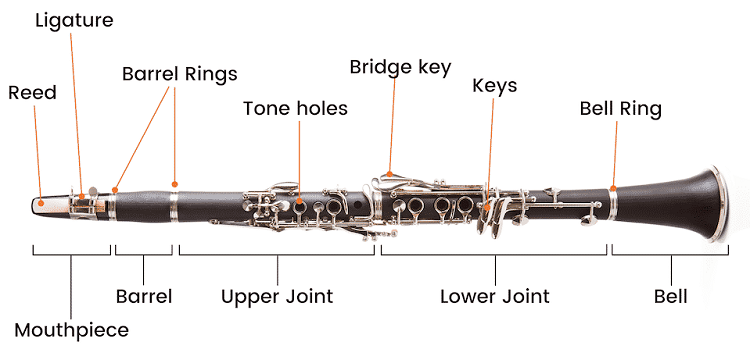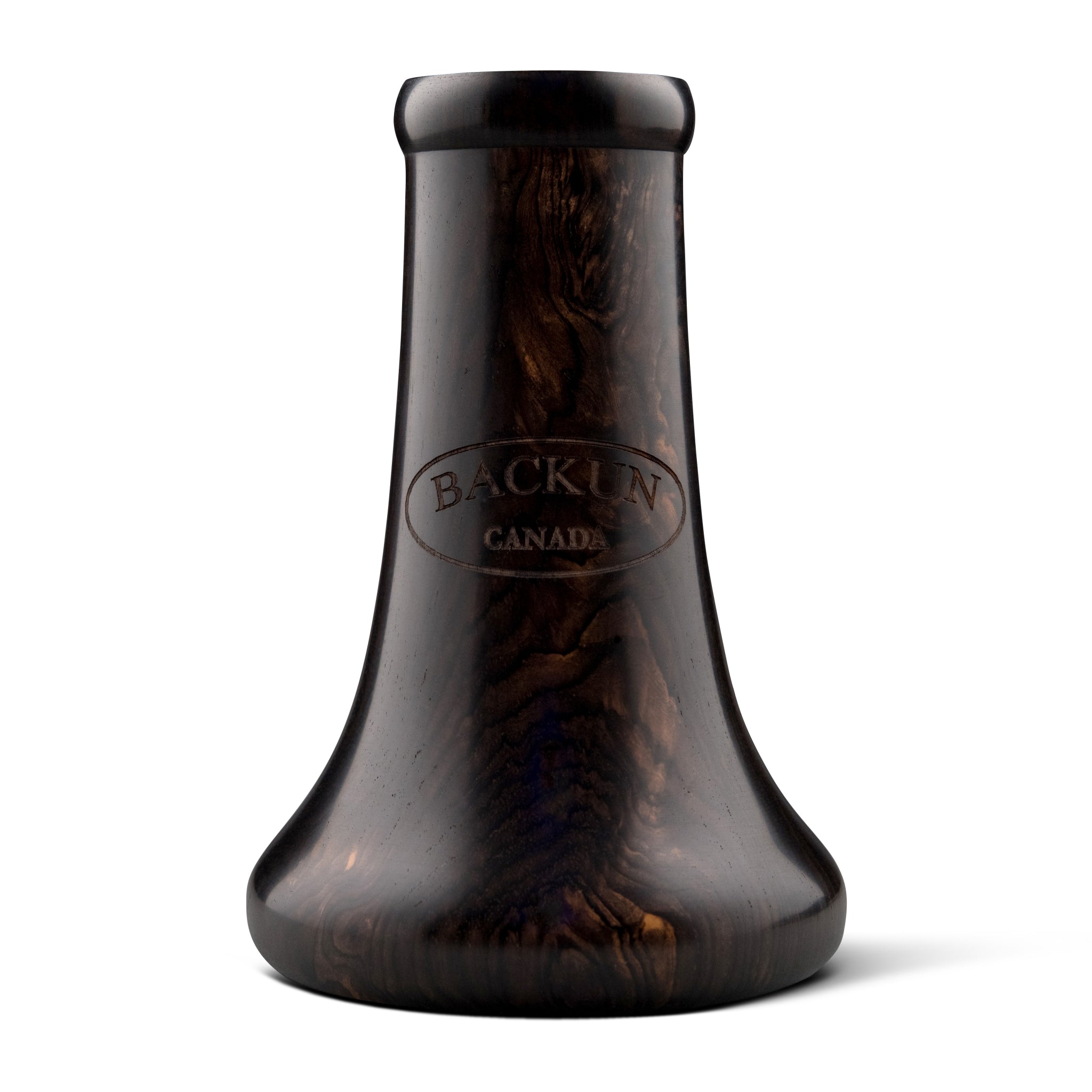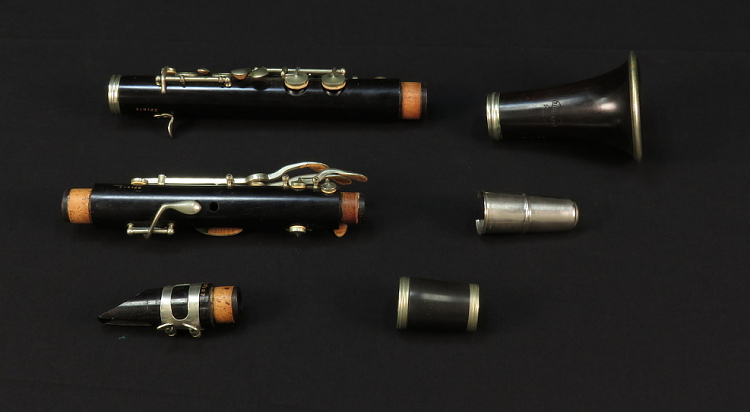- Top Trumpet Embouchure Techniques: Options for Beginners Through Professionals - October 12, 2022
- Is the Trumpet Hard to Learn? - September 30, 2022
- Best Leblanc Clarinet Models Guide: From Soprano to Contrabass - September 5, 2022
When you look at the clarinet, you may feel like you could never learn how everything works. Fortunately, getting the clarinet parts explained to you can help.
I first tried a clarinet almost nine years ago, and I enjoyed it from the start. While the instrument is a bit painful on my right thumb, it’s still fun to play and listen to clarinet music when I can.
However, I’m the first to admit the clarinet is not a simple instrument. You should learn more about the parts to help start or get better at it.
Bottom Line Up Front: The clarinet parts include a mouthpiece, ligature, reed, barrel, upper joint, lower joint, and barrel. There are smaller parts within each piece that players should also know.
Overview of the Clarinet Parts
When I first tried a clarinet, I was a bit overwhelmed by all of the parts. Especially compared to other woodwinds, such as the flute and saxophone, the clarinet has a lot of elements.
To help you assemble your clarinet, you should know what each part is and how it contributes to the instrument. Then, you can put your model together and start playing.
Here are the basic clarinet parts that all players should understand.
Mouthpiece
When you play the clarinet, you’ll put the mouthpiece in your mouth. This part features a bit of a slope and an opening on the back side.
You can find mouthpieces for all types of clarinets, and you can find models in various materials. The mouthpiece can have a decent effect on the sound you get out of your instrument.
Most beginners start on a plastic mouthpiece, including me when I started. However, I bought a better model after playing the clarinet for a while, though you don’t have to do that.
Ligature
If you buy a mouthpiece, it may or may not come with a ligature. I’ve found that student models tend to come with the mouthpiece and ligature as a set.
However, professional clarinetists can buy a mouthpiece from one brand and a ligature from another. Some ligatures have one screw, while others have two.
You might also find some ligatures where the screws sit on the back, so underneath the mouthpiece as you play. Others will sit on top, and you’ll screw it on using your right hand, even if you’re a lefty.
I’ve seen a lot of ligatures come with a mouthpiece cap. You can use the cap when you’re not playing to protect the mouthpiece and reed.
Reed
The clarinet reed is what helps you produce a sound. You’ll place the reed against the back of the mouthpiece and line it up with the opening.
Make sure it sits parallel and that the reed isn’t crooked since that can affect your sound and response. However, you’ll need to wet the reed before you put it with the mouthpiece.
I would just put the reed in my mouth and use my saliva to wet it, but you can use a small cup of water. Either way, you’ll place the reed where you want it and then use the ligature to secure it.
Reeds come in a few different strengths, which can affect the response you get. Most reeds use arundo donax cane, but synthetic reeds are slowly becoming more popular since they can last longer.
Barrel or Neck
Next on the clarinet, you’ll find a barrel on the Bb, A, and Eb clarinets. Lower types of clarinets will have a neck instead since it’s longer, and a short barrel doesn’t work as well for those instruments.
The barrel or neck is the part of the clarinet that connects to your mouthpiece. It can have a bit of an impact on the sound, and you can choose between plastic and wood barrels.
Some barrels have special designs to help change the tone. However, the barrel or neck’s main job is to help the clarinet player adjust the intonation if they’re too sharp or flat.
You can find barrels in slightly different lengths (like a millimeter shorter or longer). That can further help you get your clarinet in tune, so many players have two barrels on hand.
Barrel Rings
Not all clarinet barrels feature metal rings on the top and bottom, but plenty of them do. I’m not totally sure what the rings do, but they aren’t necessary for a good clarinet barrel.
I’ve found rings are more common on student or intermediate barrel models. However, a lot of professional barrels are just wood.
However, the wood-only barrels may still have a round “lip” of wood at the top and bottom. That might make it easier to connect the barrel to the mouthpiece and to the main clarinet body.
Upper Joint
Now, you’ve finally made it down to the main part of the clarinet where your fingers go. The upper joint contains the throat keys for notes like A and Bb.
It also includes most of the other keys you trigger with your left hand. A few sit on the bottom joint, which I’ll cover next, and both joints have to work together.
To make that happen, both joints feature a bridge key on the back. If you don’t line up the bridge key, certain notes and fingerings, such as the 1 and 1 Eb/Bb fingering, will be impossible.
Lower Joint
The lower joint is the other main portion of the clarinet, and you’ll primarily use your right hand to play it. As I mentioned, it has to fit together perfectly with the upper joint, so you’ll find its part of the bridge key near the top.
On the back, you’ll also find a thumb rest for your right thumb to help support the instrument. If that’s not enough, a lot of Bb and A clarinets have a ring above the rest so that you can connect a neck strap.
Most of the keys on this joint are for the lower parts of the lower and upper registers. Even the keys that you press with your left pinky are for low notes, and you can use your left pinky if you have to use your right pinky to press another key.
Keep in mind that the Eb clarinet usually doesn’t have separate upper and lower joints. It’s small enough that it doesn’t make sense to use two parts.
Tone Holes
As you look at the upper and lower joints, you may wonder what the open holes are. The upper joint has four tone holes, while the lower joint has three.
You’ll use your first, second, and third fingers of each hand to close those holes. On the upper joint, you also need to use your thumb to close the hole on the back.
Most of the tone holes feature metal rings that you’ll press as you close the holes. That can help you produce the right note without needing to use forked fingerings.
Keys
Along with tone holes, you will need to press keys to open and close pads that you can’t reach easily. On the upper joint, for example, are the throat keys that you open and close to play G#, A, and Bb in the staff.
You’ll also find the register key on the back, and you have to press that to play B in the staff or higher. The other common key on the left hand is the C#/G# key, and you use your left pinky for that.
On the lower joint, you’ll find some keys that you press with the lowest joint of your right index finger. However, you’ll more commonly use the four pinky keys. Some lower clarinets have even more right-hand pinky keys.
Also, lower clarinets tend to use all keys, even for the notes your first three fingers play. The tone holes would be too big for your fingers to cover completely, so keys are a better choice.
Tenons
When you look at the mouthpiece and the upper and lower joints, you’ll see a smaller part on one or both ends. You should notice some cork on that part, and that refers to the tenon.
If you just got a new clarinet, you’ll need to apply cork grease to moisten the cork. I prefer cork grease from a tube since you can apply it without getting it on your fingers.
Even if you’ve had your clarinet for a while, you should still use cork grease whenever the cork appears to dry out. Then, you can keep from damaging the cork and not being able to assemble or disassemble the clarinet.
Bell
At the bottom of your clarinet, you’ll find a bell, which is where the clarinet slightly flares out. The bell helps project your sound when you’re playing solo or in a group.
Like barrels, some bells feature a ring near the top where it connects to the lower joint. However, you can find plenty of bells without metal rings.
The right bell can help you play well, especially if you struggle to play loudly. Most clarinets come with a bell, so you might not need to buy one separately if you like the one that comes with your instrument.
On smaller clarinets, the bell is usually plastic or wood. If you buy a low clarinet, the bell will almost always use metal.
Floor Peg
Speaking of large clarinets, a lot of them will come with a floor peg that you can attach to the back. I’ve seen floor pegs on bass clarinets and contrabass clarinets.
Some alto clarinets also have a floor peg, but others might require a neck strap for support. The floor peg is nice because you don’t have to place any weight on your neck.
However, it can restrict how you move as you play. Most people need to sit when they play low clarinets, and you can’t easily move around, which I like to do, especially when playing something from memory.
Clarinet Parts That You Can Upgrade
As you advance on the clarinet, you might find your instrument is holding you back from playing your best. When that happens, it can be tempting to buy a whole new clarinet.
Fortunately, you can upgrade part of your clarinet if you can’t get a new instrument. As I mentioned earlier, I upgrade my clarinet mouthpiece when the one that came with my clarinet stopped meeting my needs.
I also swapped out the reed and ligature, and changing reeds is probably the most common upgrade. Beginners usually start on a reed with a strength of 2 or 2.5, but you can get a strength 3 reed as you build up your airspeed.
You can also upgrade the barrel, especially if you’re constantly playing sharp or flat. The bell is another option to upgrade if you choose.
Another Way to Upgrade Your Clarinet
You can also upgrade your clarinet without swapping out any of the parts. I’ve tried the LeFreque Sound Bridge on my piccolo (though not my clarinet), and it did change the sound a bit.
Some musicians swear by what the sound bridge can do, while others think the product is a gimmick. I’d suggest you try the various metals for yourself to decide if it works for your clarinet.
Why Upgrade Part of Your Clarinet
You might wonder why it’s worth upgrading part of your clarinet. Shouldn’t you just save your money and buy a better clarinet in the next year or so?
That can be a good option for some people, but it’s not for everyone. For example, an amateur player may not want to spend thousands on a new clarinet.
Here are a few reasons why small upgrades can be a good option.
Save Money
Probably the best reason to upgrade part of your clarinet is to save money. Intermediate clarinets start at around $1,500, and not everyone has that much money to spend.
Paying $100 for a better mouthpiece is a lot more economical. You can still get a good sound, but your bank account will thank you.
I wouldn’t necessarily recommend small upgrades if you plan to get a new clarinet in the future. But once you find your forever clarinet, small upgrades can help.
Improve Your Sound
As you get better at the clarinet, you might notice you aren’t getting the sound you want. Choosing a new mouthpiece or reed might be all you need to do to get a nice tone.
I’d recommend trying a few mouthpieces and reeds before you buy one. You can go to a music store to try mouthpieces to see which you like the best.
If you want to try new reeds, consider buying them individually instead of in a box. Sadly, you can’t usually try a reed without buying it.
Experiment with Materials
Another benefit of small upgrades is that you can test out new materials. Maybe you have a student plastic clarinet, but you want to see what wood might do to the sound.
You could buy a wood barrel to add to your setup. It might not do a whole lot, but it could help you get a warmer tone that you may prefer over your current barrel.
Wood requires a lot of care, and it can crack easily. So testing it out with smaller pieces is a nice option before you invest in a full wood instrument.
FAQs about Clarinet Parts Explained
Answer: The clarinet probably has multiple parts for a few reasons. First, splitting the body into two joints makes it easier to store and transport the clarinet since the case is more square.
Having multiple parts also makes it easier to adjust the intonation so that you can play in tune with others. If the clarinet was one big piece, you’d have to rely more on your air stream to change the pitch.
Answer: Most clarinets have the same parts, but there are some differences. First, the Eb clarinet only has one piece for the body, so it doesn’t feature separate joints.
Also, the lower clarinets, such as alto and bass, feature a neck instead of a barrel.
Answer: You can’ interchange clarinet mouthpieces with other instruments of the same size. Also, many clarinet players use the same mouthpiece on their Bb and A clarinets.
However, you can’t use a Bb mouthpiece on a bass clarinet or Eb clarinet. The same is true the other way, but many clarinets of all sizes come with a suitable mouthpiece.
Answer: The clarinet is black because most intermediate and advanced models use grenadilla wood. Student models use an ABS resin, which is a type of plastic.
You can find some clarinets that use rosewood and so have a reddish-orange color. Either way, the materials are the reason for the instrument’s color.
Answer: Like other woodwinds, clarinets have holes because that’s how you change notes. You’ll close more of the holes to produce a lower note and open more holes for a higher note.
Final Note on Clarinet Parts Explained
Having the main clarinet parts explained to me would have been so useful when I first learned the instrument. If you’re looking to play the clarinet, consider what the parts are and what they do.
That can help you learn the fingerings and how to manipulate your air to play more of the notes. Soon enough, you might be able to play some massive solos or simply join your local orchestra or wind ensemble.
For more interesting readings check out:



